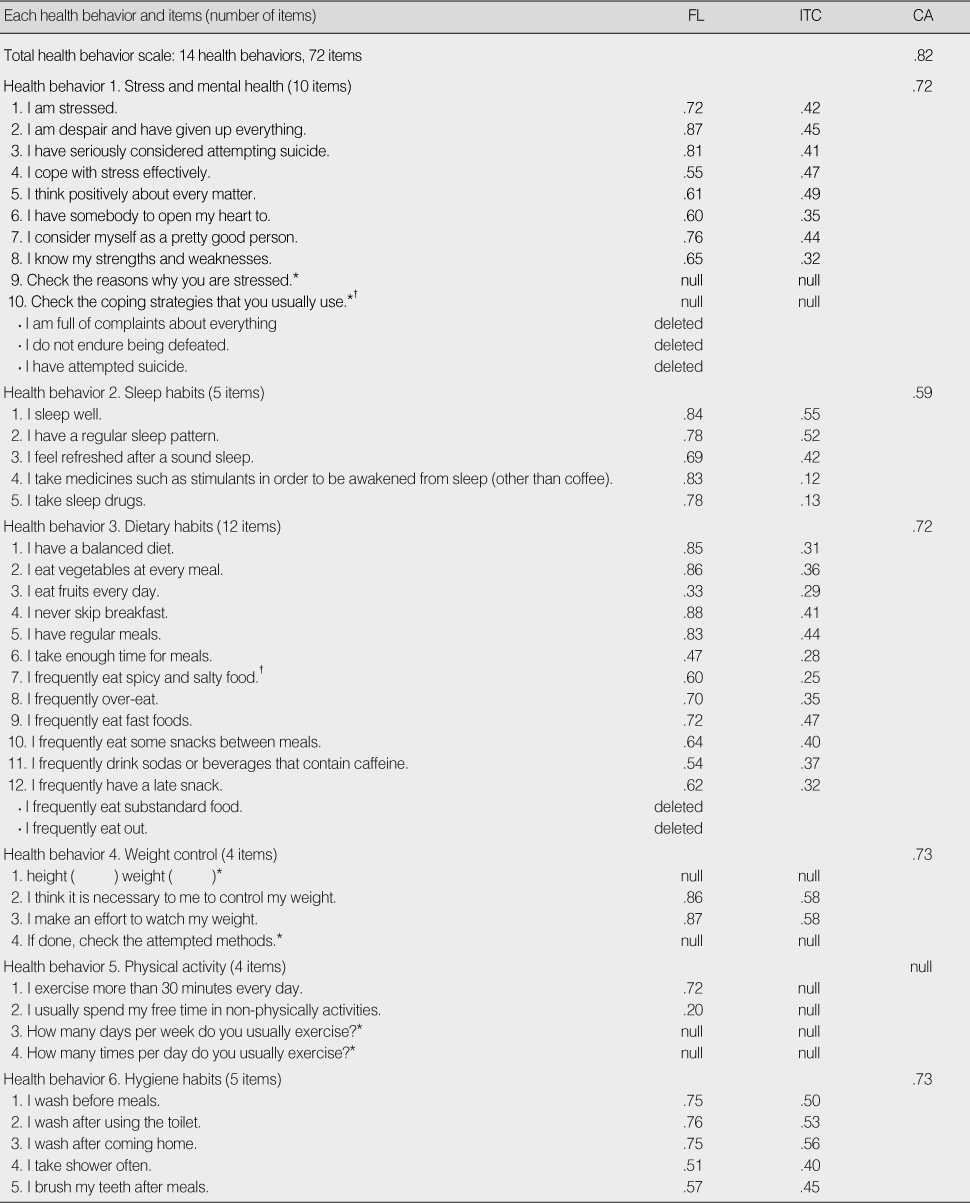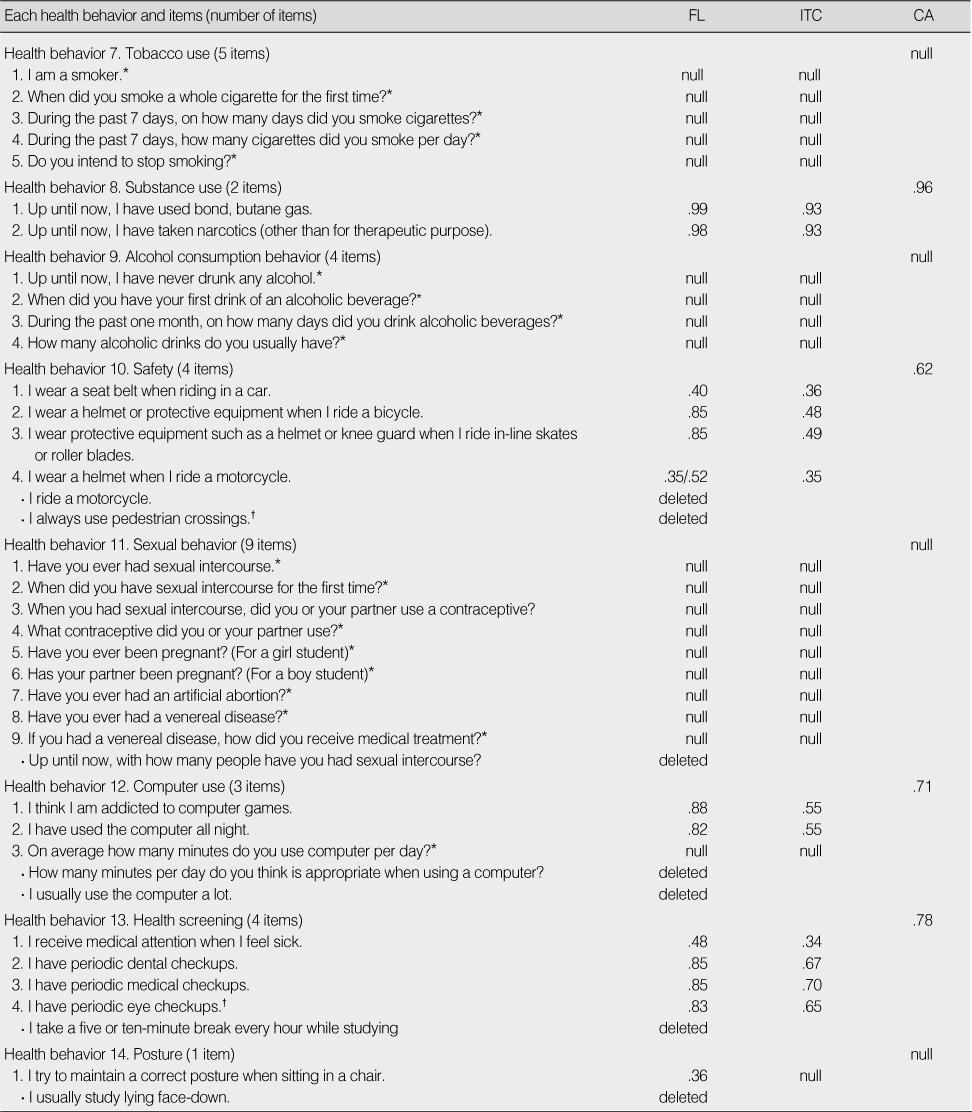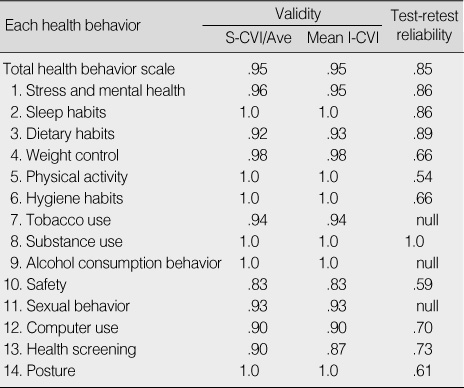Articles
- Page Path
- HOME > J Korean Acad Nurs > Volume 40(6); 2010 > Article
-
Original Article
- Development and Psychometric Evaluation of a Scale to Measure Health Behaviors of Adolescents
- Yun Hee Shin
-
Journal of Korean Academy of Nursing 2010;40(6):820-830.
DOI: https://doi.org/10.4040/jkan.2010.40.6.820
Published online: December 31, 2010
Professor, Department of Nursing, Wonju College of Medicine, Yonsei University, Wonju, Korea.
- Address reprint requests to: Shin, Yun Hee. Department of Nursing, Wonju College of Medicine, Yonsei University, 162 Ilsan-dong, Wonju 220-701, Korea. Tel: 82-33-741-0387, Fax: 82-33-743-9490, yhshin@yonsei.ac.kr
Copyright © 2010 Korean Society of Nursing Science
Abstract
-
Purpose
- The purpose was to develop a preliminary scale to measure Korean adolescents' health behaviors through a qualitative approach, to evaluate the scale psychometrically, and to develop a final scale.
-
Methods
- Participants were 61 adolescents for qualitative interviews and 1,687 adolescents for the psychometric evaluation. Procedure included content analysis of interviews to identify health behavior categories for Korean adolescents, pre-test to confirm that preliminary scale items were understandable, content validity by an expert panel, development of the web-based computer-assisted survey (CAS), and psychometric analysis to determine reliability and validity of the final scale.
-
Results
- A final scale was developed for both paper-and-pencil and CAS. It consisted of 14 health behaviors (72 items), including stress and mental health (10), sleep habits (5), dietary habits (12), weight control (4), physical activity (4), hygiene habits (5), tobacco use (5), substance use (2), alcohol consumption (4), safety (4), sexual behavior (9), computer use (3), health screening (4), and posture (1).
-
Conclusion
- The scale's strong points are: 1) Two thirds of the final scale items are Likert scale items, enabling calculation of a health behavior score. 2) The scale is appropriate to Korean culture. 3) The scale focuses on concrete health behaviors, not abstract concepts.
This work was supported by the Korea Research Foundation Grant funded by the Korean Government (MOEHRD, Basic Research Promotion Fund) (KRF-2008-313-E00667).
- 1. An JY, Tak YR. Health-risk behaviors and self-efficacy in early adolescents. Journal of Korean Academy of Community Health Nursing. 2006;17:387–396.
- 2. Barnes M, Courtney MD, Pratt J, Walsh AM. School-based youth health nurses: Roles, responsibilities, challenges, and rewards. Public Health Nursing. 2004;21:316–322.ArticlePubMed
- 3. Byun YS, Lee HY. A study on health risk behaviors in adolescents. Journal of Korean Academy of Fundamentals Nursing. 2005;12:413–420.
- 4. YRBSS: Youth risk behavior surveillance system, 2009. Centers for Disease Control and Prevention. 2010;Retrieved April 22, 2010. from http://www.cdc.gov/HealthyYouth/yrbs/.
- 5. Chen MY, James K, Wang EK. Comparison of health-promoting behavior between Taiwanese and American adolescents: A cross-sectional questionnaire survey. International Journal of Nursing Studies. 2007;44:59–69.ArticlePubMed
- 6. Clark LA, Watson D. Constructing validity: Basic issues in objective scale development. Psychological Assessment. 1995;7:309–319.Article
- 7. Cureton EE, D'Agostino RB. Factor analysis: An applied approach. 1983;Hillsdale, NJ, Erlbaum.
- 8. Elo S, Kyngäs H. The qualitative content analysis process. Journal of Advanced Nursing. 2007;62:107–115.Article
- 9. Everitt BS. Multivariate analysis: The need for data and other problems. The British Journal of Psychiatry. 1975;126:237–240.ArticlePubMed
- 10. Gochman DS. Gochman DS. Health behavior research: Definitions and diversity. In: Handbook of health behavior research, vol. I. Personal and social determinants. 1997;New York, Plenum Press.
- 11. Harrison PA, Beebe TJ, Park EK. The adolescent health review: A brief, multidimensional screening instrument. Journal of Adolescent Health. 2001;29:131–139.Article
- 12. Harrison PA, Beebe TJ, Park EK, Rancone J. The adolescent health review: Test of a computerized screening tool in school-based clinics. Journal of School Health. 2003;73:15–20.ArticlePubMed
- 13. Kann L, Brener ND, Warren CW, Collins JL, Giovino GA. An assesment of the effect of data collection setting on the prevalence of health risk behaviors among adolescents. Journal of Adolescent Health. 2002;31:327–335.Article
- 14. Kim HS. A study on the relations of health promoting behavior and perceptions of body-image in middle school students. 2006;Seoul, Seoul National University. Unpublished master's thesis.
- 15. Kim MS. A study on health-promotion behavior of adolescents and influential factors. 2003;Seoul, Kyung Hee University. Unpublished master's thesis.
- 16. Kim SYJ. Human growth and development and nursing of adolescents. 2004;Seoul, Soomoonsa.
- 17. Korea Centers for Disease Control and Prevention. A guide to use the original data for the fourth Korea youth risk behavior web-based survey. 2010;Seoul, Author.
- 18. Kwon SJ. A study on the correlation between health behaviors of adolescents and social factors. Journal of the Korean Society of School Health. 1996;9:69–75.
- 19. Lee JG. Understanding and use of SAS: To analyze experimental and survey data. 1993;Seoul, Sungweonsa.
- 20. Millstein SG, Petersen AC, Nightingale EO. Promoting the health of adolescents: New directions for the twenty-first century. 1993;New York, Oxford University Press.
- 21. Park EO, Hyun MY. Problems and improvements in surveys on health risk behaviors among adolescents in Korea. Journal of the Korean Society of School Health. 2005;8:59–69.
- 22. Perry CL. Creating health behavior change: How to develop community-wide programs for youth. 1999;Thousands Oaks, CA, Sage Publications, Inc.
- 23. Polit DF, Beck CT, Owen SV. Is the CVI an acceptable indicator of content validity? Appraisal and recommendations. Research in Nursing & Health. 2007;30:459–467.Article
- 24. Population Census. Statistics Korea. 2005;12 27 Retrieved April 22, 2010. from http://kostat.go.kr/portal/index/statistics.action.
- 25. Seol YH. Comparison of stress and health behavior between children in the broken family and those in the normal family. 2007;Gwangju, Chonnam National University. Unpublished master's thesis.
- 26. Shin Y. Health promotion. 2009;Seoul, Gyechuk Munwhasa.
- 27. So HY, Kim HL. Health promoting behavior of adolescents. Journal of Korea Community Health Nursing Academic Society. 1998;12:107–121.
- 28. Walker SN, Sechrist KR, Pender NJ. The health promoting lifestyle profile development and psychometric characteristics. Nursing Research. 1987;36:76–81.PubMed
- 29. Zaborskis A, Lenciauskiene I. Health behavior among Lithuania's adolescents in context of European union. Croatian Medical Journal. 2006;47:335–343.PubMedPMC
- 30. Zullig KJ, Pun S, Patton JM, Ubbes VA. Reliability of the 2005 middle school youth risk behavior survey. Journal of Adolescent Health. 2006;39:856–860.Article
REFERENCES
Figure & Data
REFERENCES
Citations

- The Moyamoya Health Behavior Scale for Adolescent Patients: Measurement Tool Development and Psychometric Evaluation
Won-oak Oh, Insun Yeom, Sung-Hyun Lim, Dong-Seok Kim, Kyu-won Shim
International Journal of Environmental Research and Public Health.2021; 18(8): 4064. CrossRef - Health Behaviors and Related Demographic Factors among Korean Adolescents
YunHee Shin, Sook Jung Kang
Asian Nursing Research.2014; 8(2): 150. CrossRef - Health Behaviors among Korean Adolescents: A Content Analysis
Yun Hee Shin, Jihea Choi
Korean Journal of Health Promotion.2014; 14(3): 83. CrossRef - Lecturers’ Performance and Technology at Private Higher Education in South Sulawesi Indonesia
Sanusi Hamid
Procedia - Social and Behavioral Sciences.2013; 83: 580. CrossRef - Effects of a Mentoring Program on Stress and Self-esteem for Middle School Girls of Low Income Families
Yun Hee Shin, Jee Hae Lee, So Young Lee, Kyeung Min Lim, Sook Lee
Journal of Korean Academy of Psychiatric and Mental Health Nursing.2012; 21(3): 220. CrossRef - The Reliability and Validity of the Personal Competence of Health Care (PCHC) Scale
Kyung-Sook Lee, Jung-Sook Choi, Ae-Young So, Eun-Hee Lee
Journal of muscle and joint health.2012; 19(2): 197. CrossRef
Construct Validity and Reliability
*not Likert scale items; †added after confirming content validity by an expert panel.
FI=Factor loading score; ITC=Item-total correlation; CA=Cronbach's alpha; null=with no existence or not applicable.
Content Validity and Test-retest Reliability
S-CVI/Ave=Scale-level content validity index, averaging method; I-CVI=Item-level content validity index; null=with no existence or not applicable.
Eigenvalue and Cumulative Variance
*Two items of safety belonged to two factors (safety 1 and 2).
CV=Cumulative variance.
*not Likert scale items; †added after confirming content validity by an expert panel. FI=Factor loading score; ITC=Item-total correlation; CA=Cronbach's alpha; null=with no existence or not applicable.
S-CVI/Ave=Scale-level content validity index, averaging method; I-CVI=Item-level content validity index; null=with no existence or not applicable.
*Two items of safety belonged to two factors (safety 1 and 2). CV=Cumulative variance.
 KSNS
KSNS
 E-SUBMISSION
E-SUBMISSION



 Cite
Cite

